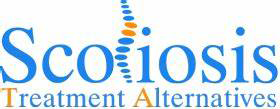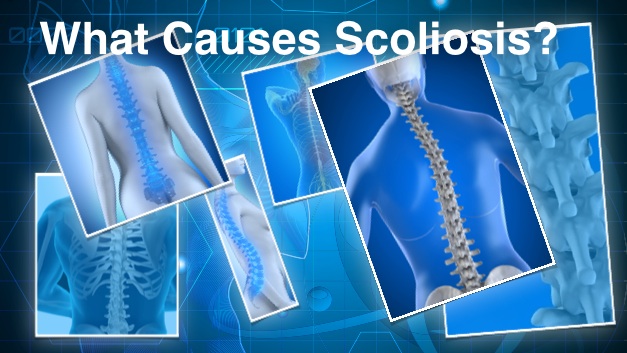Scoliosis Causes
While scoliosis is often viewed as a disease unto itself, the reality is that it’s not. Rather scoliosis is a multifactorial condition that can occur as a consequence of other issues.
While some scoliosis causes are easy to recognize, such as a congenital anomaly such as a wedged vertebra, others such as neurogenic causes are more complex. Yet the vast majority (80% of all cases of scoliosis are still classified as “idiopathic” meaning that the cause is unknown.
While there are exact causation may not yet be fully understood there is still a lot that is known about how a scoliosis starts. Research on scoliosis done by Drs. Collard and Richard allowed them to develop a hypothesis on how scoliosis begins.
Genetic Component
 Research has shown that in many cases of scoliosis there is a genetic component, yet genetics does not seem to be the sole cause of a scoliosis or it’s progression. While the genetic predisposition may be present in siblings, the expression of that genetic predisposition is not always the same. Take for instance the case of identical twins, where one many have a scoliosis and the other just a minimal curve of the spine. Although they share the identical genes, the expression of those genes seems to be affected by something else.
Research has shown that in many cases of scoliosis there is a genetic component, yet genetics does not seem to be the sole cause of a scoliosis or it’s progression. While the genetic predisposition may be present in siblings, the expression of that genetic predisposition is not always the same. Take for instance the case of identical twins, where one many have a scoliosis and the other just a minimal curve of the spine. Although they share the identical genes, the expression of those genes seems to be affected by something else.
There is a genetic marker test that can give a clinician an idea if there are genetic markers that predispose a child’s scoliosis to progress, but the information gleaned from the test is of limited value.
 The test is called Scoliscore and it’s a saliva test that professes to evaluates the risk of progression of scoliosis based on particular genetic markers. The problem is that the test does not just use the genetic marker information to come up with it’s determination on the risk for progression, it also uses the age of onset and curve degree as factors, both of which have been shown to be accurate predictors of scoliosis progression.
The test is called Scoliscore and it’s a saliva test that professes to evaluates the risk of progression of scoliosis based on particular genetic markers. The problem is that the test does not just use the genetic marker information to come up with it’s determination on the risk for progression, it also uses the age of onset and curve degree as factors, both of which have been shown to be accurate predictors of scoliosis progression.
Finding what may be driving scoliosis causes is important when it comes to finding the right treatment. While genetics plays a role in the likelihood of the progression of scoliosis there are other factors that can determine if a scoliosis will worsen. Find out what they are in this article on Epigenetics of scoliosis.
Early Detection of Scoliosis
Accurately evaluating the degree, severity and complicating factors involved in your scoliosis will determine which treatment is right for you. Discover some of the latest and most technologically advanced tools for evaluating scoliosis.
Minimizing Need for Scoliosis X-rays
Rasterstereography (aka Formetric) is a non x-ray form of imaging the spine that can be used to effectively monitor scoliosis to minimize x-ray exposure. Using this cutting edge technology can allow us to reduce the x-ray exposure to our patients by over 75% over the course of their treatment program.
Find out more about this advanced technology that has been used in many scoliosis centers in Europe and is available to patients in our offices.
Scoliosis Pain
Scoliosis Symptoms are often found with adults, yet the severity of the curvature does not necessarily correlate with the level of pain. Find out why.
Adults with scoliosis pain are often told by their doctors that there is nothing that can be done for their scoliosis pain, other than take medications. Find out about the treatments your doctor isn’t telling you about and see if they could help relieve you scoliosis pain.
Scoliosis Treatment
Review of Current Alternatives in Scoliosis Treatment – Examines and compares all types of scoliosis treatment in this FREE e-book. Find the treatment that is best for you based on your scoliosis causes.


My daughter, now 13 was diagnosed at 12. I was horrified and terrified. Luckily her curvature is less that 10 degrees. But we still have check ups every 4 months. I worry because she complains of pain and I certainly am worried about chronic pain that may follow her into adulthood. She also has a disorder where bottom jaw stopped growing and has to have corrective surgery for this. Idk if there’s a connection, our dr says no. But anyway you put it scoliosis is a scary disease and I pray for anyone who has it. God bless.
Vickie,
I am unaware of any research connecting scoliosis with a lack of growth the the mandible but there is a known increased incidents of kids who have scoliosis who also have braces. So I wouldn’t be surprised if there was a connection, it just hasn’t been fully explored yet. Because this area of the skull is very close to the centers in the brain that control posture, it’s possible that abnormalities in that region could negatively impact that area of the brainstem. Here is a research article about that. http://scoliosistreatmentalternatives.com/613/variations-cerebellum-in-ais/
I am told u r only born with scoliosis but i was not diagnosed until Nov.1st of 2012 & I was 41 yrs old had been having lots of pain & noticed one leg becoming shorter than the other …..
Is this true that I could’ve been born with it & they just didn’t notice it til I was having problems ???
It’s difficult to say for certain if your scoliosis developed as an adolescent or an adult. Both can happen. The real question is what can be done about it now. Give us a call at (800) 943-1254 for a Free Phone Consult to discuss your options. Dr. Brett Diaz, D.C.